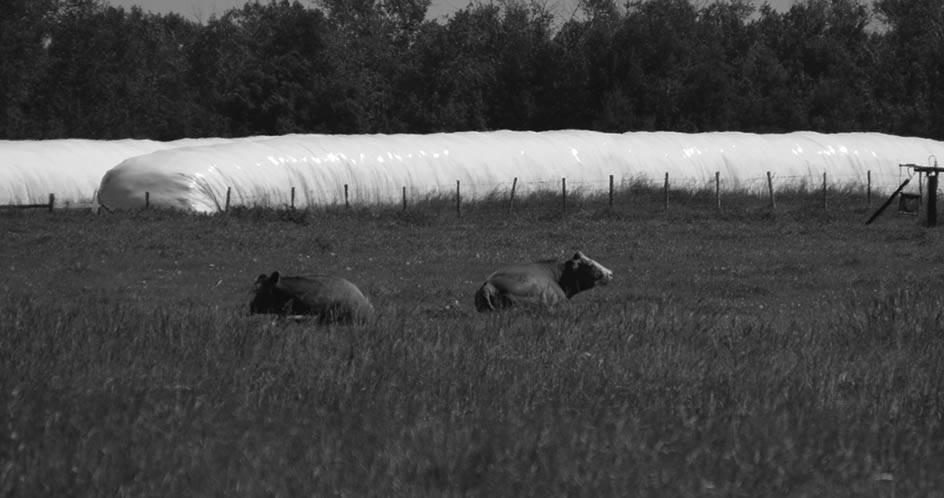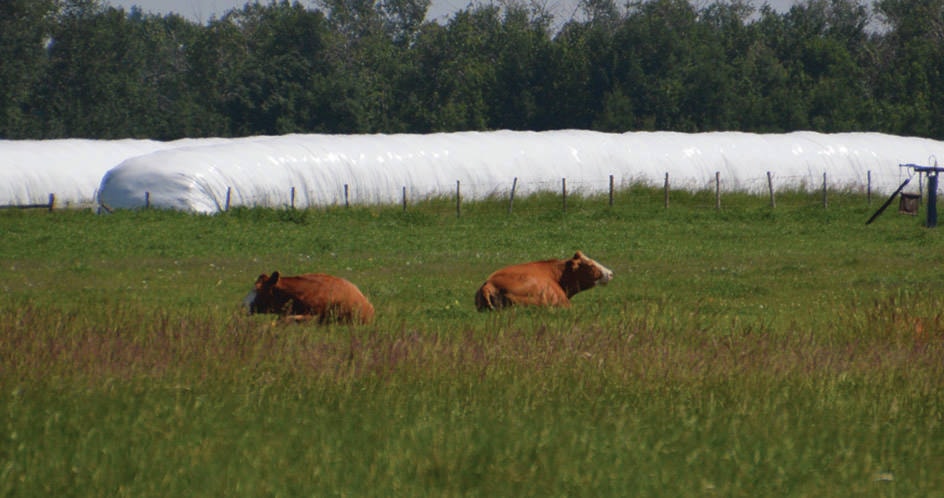When it comes to stacking bales, a little forethought can go a long way to ensuring a better product.
“Storage losses from improperly stacked bales can be anywhere from 15 to 20 per cent of the dry matter yield while protein and energy losses can be anywhere from five to ten per cent,” says Barry Yaremcio, beef and forage specialist, Alberta Agriculture and Forestry. “You spend a lot of time putting up a good quality hay, so why risk losing 10 to 15 per cent of your productivity by just not stacking the bales properly?”
Before bringing the bales into the yard, Yaremcio recommends mowing the grass that’s already present in the lot. “This will help reduce a lot of the moisture and soil-to-bale contact, and help prevent spoilage taking place from the bottom. Also, try to store the bales in a high area, so the bales don’t end up sitting in water after a rain.”
Yaremcio suggests leaving two to three feet between the rows of bales and stacking them from northwest to southeast or from wherever the prevailing winds are coming from. “This way, when the snow comes, the wind will be able to blow away the moisture so it’s not between the bales come spring.”
When it comes to stacking bales in the field, there are a number of different methods for stacking.
One method is the pyramid style, with three bales on the bottom, two in the middle and one on the top. “That’s actually the poorest way to do it,” says Yaremcio. “If it rains after the stacks are made, or if snow melts during the winter, all that moisture will works its way through the stack from the top down, and cause spoilage wherever the bales contact each other.”
He says the mushroom stack, with bottom bale flat and the second one on top, is better than the pyramid but still will end up with a lot damage. “The best method, however, if you have the space, is to put single bales in rows with the individual bales in the rows separated by about six to ten inches so they don’t touch.”
If using a tarp, Yaremcio recommends leaving the ends open so air can blow between the tarp and bales. “That way, the wind can carry any moisture that has evaporated out of the bales and condensed on the inside of the tarp away before it drops back onto the bales and causes damage.”
For more information, call the Alberta Ag-Info Centre at 310-FARM (3276).
When to cut hay
While hay may look and smell fine, appearances may be deceptive and tests will need to be done to make sure the quality is there.
“Cutting hay early will give you a higher quality product,” says Barry Yaremcio, beef/forage specialist, Alberta Ag-Info Centre. “Mixed hay or a predominantly grass hay will drop between 1 to 1.5 percent protein per week as it matures, and the energy content (TDN) will also decrease two to three points.”
If a producer is looking to mix this year’s hay with hay carried over from last year, or with a spring crop that was baled instead of combined, the higher-quality product will be needed to make up for the deficiencies in the older material.
Yaremcio says timing depends largely on location.
“Parts of southern Alberta are fairly dry and hay is short. You’re not going to get a lot of volume, but the longer you wait the more problems you will have. Same goes for the Fort Vermilion-La Crete area. Things are also dry there and producers will need to get the hay off early so that if there is some additional moisture, they’ll have a chance for a second cut.”
For areas of the province that have had too much moisture, Yaremcio says there are two concerns. “A lot of the nitrogen was leeched down below the rooting zone of the plant meaning protein content may be lower than normal. Secondly, the rapid growth rates could also reduce the amount of energy present.”
For more information, contact the Alberta Ag-Info Centre at 310-FARM (3276)

